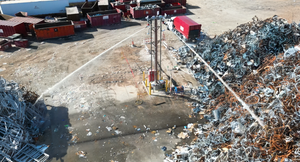Stabilizing Spain
March 1, 2004
Ignasi Puig Ventosa ENT Environment and Management Vilanova Spain www.ent-consulting.com ipuig@ent-c
ALTHOUGH IT IS HUNDREDS of miles across the ocean, the small town of Torrelles de Llobregat, Spain, has learned to increase its recycling rate by following its American and other foreign compadres.
Situated within the metropolitan area of Barcelona, Torrelles de Llobregat has historically been able to compost and recycle a significant portion of its waste stream. Prior to 2002, collection was based on using containers for paper, glass, biowaste and refuse, and 45 percent of the waste collected in the city was diverted from landfills. As in the majority of Spanish municipalities, households were charged a fixed annual fee of 62.50 Euros or approximately $80 for collection. Many residents who generated smaller amounts of waste considered this fee unfair because they believed they were subsidizing higher waste producers.
To overcome this discrepancy and to increase the diversion rate, which had begun to stabilize, the local environmental council decided to examine collection methods being used in the United States, Italy and Belgium. The council noted that these countries' pay-as-you-throw (PAYT) programs have been running successfully for years and decided that, based on Torrelles de Llobregat's population of 4,100 and type of urbanization, it would be an ideal city for PAYT as well.
PAYT, which links the cost of trash collection to the amount thrown away, is the first such program in Spain and was supported by both the regional Government (Junta de Residus, Generalitat de Catalunya) and the Metropolitan Area of Barcelona government (Entitat Metropolitana del Medi Ambient). However, the cost of the new collection system increased the city's operational costs by 17 percent.
Thus, to smooth the transition to the new PAYT system during the first year, the council designed the variable fee to pay for 40 percent of the total cost of collecting residents' waste. A flat fee of approximately $40 (35 Euros), similar to the tax in the previous collection system but at half the value, also was maintained to pay for the remaining 40 percent of collection costs. The final 20 percent of the waste collection costs is absorbed in the municipal budget, as in previous years.
Since the new collection system and tax were implemented in January 2003, biowaste, paper and cardboard, glass, and diapers are collected free of charge. All other waste, consisting mainly of packages and refuse, must be left for collection inside special standardized bags provided by the council through 17 local retailers. The cost of the bags is paid for by residents, which allows the council to cut the flat collection tax in half.
According to the council, a 40-liter bag, equivalent to approximately 10 gallons, costs approximately 76 cents (0.6 Euros). When residents use more bags, they pay higher fees, which has created an incentive toward waste reduction and recycling. Larger capacity bags of 100 liters (26 gallons) at approximately $1.90 (1.50 Euros) are available for commercial businesses. Large commercial producers of biowaste also are charged annually for a biowaste bin. The rate depends upon the size of the bin and the collection frequency.
Seven months after implementing PAYT, the town reports that its recycling rate has increased to 83 percent and the quality of the collected materials has improved. Additionally, the number of recycling center users has almost tripled, primarily because recyclables can be disposed of free of charge, if properly sorted. The recycling center receives 0.67 visits per household per month, which is the highest rate in Spain, according to the council.
Yet the path to PAYT was not entirely smooth. Prior to implementing the user fee-based system, the council and regional administrations spent approximately 18,000 Euros, or $23,000, in consulting fees to design the collection and fiscal system. Approximately $39,000 (30,600 Euros) was spent on communication and information dissemination. The collection cost for the first year has been 190,242 Euros or approximately $241,000. But despite the local participation and cooperation in designing the PAYT system, the council says there still was a lack of consensus between local political parties, which caused some citizens to be reluctant to use the standardized bags. Even today, the bag use is widespread, but disagreements about the convenience of a PAYT system remain.
Additionally, the council has detected some illegal dumping problems and estimates that approximately 10 percent of the waste stream is being disposed of outside the program's boundaries. But through education efforts, many industries that previously were using the municipal system illegally have stopped. This accounts for the reduced quantities of collected waste since January 2003.
Today, many residents believe the new variable rate PAYT program is fairer than the old collection fee system and capable of fostering waste minimization and recycling. The council also believes similar PAYT projects could be implemented in larger, more compact cities, with some program adaptations. Industry professionals believe that PAYT models will spread throughout Spain as their benefits become more widely recognized.
You May Also Like


.png?width=300&auto=webp&quality=80&disable=upscale)